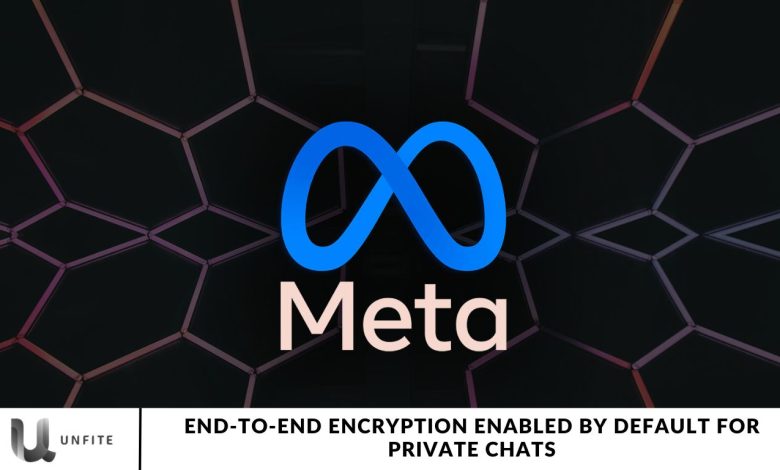End-to-End Encryption Enabled by Default for Private Chats

Meta announced on Wednesday that end-to-end encryption (E2EE) is now the default for individual chats on Facebook Messenger. In the coming weeks and months, Meta, Facebook’s parent company, will roll out this protection to both new and existing conversations.
Encrypted chats will offer the same features as unencrypted ones, including custom message reactions, messaging themes, and the ability to unsend messages.
Facebook Messenger Turns End-to-End Encryption on by Default for Individual Chats
Loredana Crisan from Messenger announced in a recent post that secure calling and one-on-one chats on the messaging app are now protected with end-to-end encryption (E2EE). She emphasized that Meta collaborated with authorities, researchers, educators, and activists to strike a balance between safety and privacy.
The critical change is that Messenger can no longer access chat content, similar to how Meta’s WhatsApp operates. However, if a participant reports content from a conversation, Meta can review the E2EE message details, a feature that WhatsApp also supports.
Messenger’s E2E encrypted chat feature, Secret Conversations, launched in 2022, has been enhanced to include some standard chat functionalities. Users can now send stickers and GIFs, and in private chats, they can customize chat themes.
Screenshot Alerts Added in E2EE Chats
Meta Messenger has stated that end-to-end encrypted (E2EE) chats now offer functionalities similar to those in regular chats. Users opting for the 24-hour disappearing message mode will also receive notifications when a snap is taken.
In previous announcements, Meta CEO Mark Zuckerberg revealed plans to integrate Instagram and Messenger with default E2EE chats, indicating that encrypted chats would become the standard setting permanently.
The company claims to utilize its own Labyrinth Protocol in conjunction with the Signal Protocol, which is widely regarded as the industry standard for encrypted messaging applications like Signal.
What is End-to-End Encryption?

Definition of End-to-End Encryption
End-to-end encryption (E2EE) is a secure communication method that ensures that only the communicating users can read the messages. In this system, data is encrypted on the sender’s device and only decrypted on the recipient’s device. This means that even if the data is intercepted while in transit, it remains unreadable to anyone other than the intended recipient. E2EE is commonly used in messaging apps, email services, and file-sharing platforms to protect sensitive information from unauthorized access.
Explanation of How E2EE Works
E2EE works through a process that involves several key steps:
Encryption at the Source: When a sender composes a message, the message is encrypted using a unique encryption key that only the sender and intended recipient possess. This key is typically generated during the initial setup of the messaging service.
- Transmission: The encrypted message is sent over the internet. Even if the message is intercepted by a third party (such as hackers or service providers), it remains encrypted and unreadable.
- Decryption at the Destination: Upon receiving the message, the recipient’s device uses the corresponding decryption key to convert the encrypted message back into its original, readable format. This decryption can only occur on the recipient’s device, ensuring that no one else can access the content.
- Key Management: The encryption keys are crucial to the process. They are generated and stored securely on the users’ devices rather than on central servers, further protecting against unauthorized access.
Importance of E2EE for Safeguarding Personal Communications
End-to-end encryption plays a vital role in safeguarding personal communications for several reasons:
- Privacy Protection: E2EE ensures that personal messages, sensitive information, and private conversations remain confidential. Only the intended recipients can access and read the content, protecting users from prying eyes.
- Security Against Interception: In an era where cyber threats are prevalent, E2EE provides robust protection against eavesdropping and data breaches. Even if attackers gain access to the network, the encrypted data remains secure.
- User Trust: With growing concerns about data privacy, E2EE fosters user trust in communication platforms. Users are more likely to engage with services that prioritize their privacy and employ strong security measures.
- Legal Compliance: In many jurisdictions, regulations require companies to protect user data. Implementing E2EE helps organizations comply with these laws while providing users with peace of mind.
- Empowerment: E2EE empowers users by giving them control over their communications. They can communicate freely without fear of surveillance, enabling open dialogue and fostering a safe online environment.
Why Default E2EE is a Game Changer for Private Chats
Increased User Trust and Confidence in Messaging Platforms
The implementation of end-to-end encryption (E2EE) as the default setting for messaging platforms significantly boosts user trust and confidence. When users know that their conversations are encrypted and protected from unauthorized access, they feel safer using the platform. This trust is essential, as it encourages users to engage more openly and frequently, knowing that their private communications are secure. Furthermore, messaging services that prioritize user privacy through E2EE are more likely to attract new users who are increasingly concerned about data security in today’s digital landscape.
Protection Against Unauthorized Access and Data Breaches
End-to-end encryption provides a robust layer of protection against unauthorized access and data breaches. By ensuring that only the sender and intended recipient can decrypt messages, E2EE effectively prevents third parties—including hackers, governments, and even service providers—from accessing sensitive information. This protection is crucial at a time when cyber threats are becoming more sophisticated and prevalent. With E2EE in place, users can communicate without worrying about their data being intercepted or exploited, significantly reducing the risk of identity theft, harassment, and other malicious activities.
Overview of How This Shift Aligns with User Privacy Expectations
The shift towards default end-to-end encryption aligns closely with evolving user privacy expectations. As individuals become more aware of data privacy issues and the potential for misuse of personal information, there is a growing demand for secure communication methods. Users expect messaging platforms to provide robust security features that protect their data from unauthorized access. By adopting E2EE as the standard, companies demonstrate their commitment to safeguarding user privacy and responding to these expectations.
This alignment also reflects broader societal trends emphasizing digital rights and individual privacy. As data breaches and scandals involving unauthorized data usage continue to make headlines, users are increasingly prioritizing platforms that respect their privacy. By implementing E2EE, messaging services not only meet user expectations but also enhance their brand reputation, establishing themselves as leaders in user-centric privacy practices.
Key Features of End-to-End Encrypted Private Chats
Secure Messaging
End-to-end encryption (E2EE) ensures that messages are encrypted from the moment they are sent until they reach the intended recipient. When a user sends a message, it is transformed into an unreadable format using a cryptographic key that is unique to that conversation. This key is stored only on the users’ devices, not on central servers, ensuring that only the sender and recipient can access the message.
During transmission, the encrypted message travels over the internet, remaining secure against interception. Only the recipient’s device can decrypt the message back into its original form using the corresponding key. This robust security framework protects personal conversations from eavesdroppers, hackers, and even service providers, allowing users to communicate with peace of mind.
Enhanced User Control
One of the significant advantages of E2EE is the enhanced control it provides users over their communications. Features like disappearing messages and the ability to unsend texts empower users to manage their conversations more effectively:
- Disappearing Messages: Users can enable a mode where messages automatically disappear after a set period. This feature is handy for users who want to ensure that sensitive information is not permanently stored or accessible later.
- Unsending Texts: If a user sends a message by mistake, they can easily unsend it, preventing the recipient from viewing it. This functionality allows for greater flexibility and control over what is shared, contributing to a more secure messaging experience.
Customization and Usability
Despite the added layer of security provided by E2EE, users can still enjoy various customization and usability features that enhance their messaging experience:
- Messaging Themes: Users can personalize their chat backgrounds with different themes, making conversations more visually appealing and tailored to individual preferences.
- Stickers and GIFs: Users can express themselves through a variety of fun and engaging stickers and GIFs, maintaining the interactive nature of chats even in a secure environment.
- Custom Reactions: The ability to react to messages with emojis allows for nuanced communication, making interactions more lively and personalized.
User Reactions to Default E2EE

Overview of Public Perception and Acceptance of E2EE
Public perception of end-to-end encryption (E2EE) has evolved significantly over the years, particularly as concerns around data privacy and security have heightened. Many users now view E2EE as a vital feature that enhances the safety of their digital communications. Several factors primarily drive this growing acceptance:
- Increased Awareness: High-profile data breaches and scandals involving unauthorized access to personal data have raised public awareness about the importance of privacy. As users become more informed about the risks associated with unencrypted communications, the demand for E2EE has surged.
- Trust in Platforms: Users tend to favor messaging platforms that prioritize their privacy. Services that implement E2EE as a standard feature are often perceived as more trustworthy, leading to increased user loyalty and retention. Platforms like WhatsApp and Signal, which emphasize E2EE, have gained popularity as users seek secure alternatives to traditional messaging apps.
- Legitimate Security Concerns: With growing cyber threats, users are more inclined to choose platforms that offer robust security measures. E2EE addresses these concerns by providing a reliable way to safeguard personal information from potential attacks.
Feedback from Users on Enhanced Privacy Features
User feedback on enhanced privacy features associated with E2EE has generally been positive. Here are some common sentiments expressed by users:
- Increased Peace of Mind: Many users appreciate the peace of mind that comes with knowing their conversations are secure. They feel more comfortable sharing sensitive information, such as financial details or personal issues, without the fear of interception.
- Empowerment and Control: Users value the enhanced control provided by features like disappearing messages and the ability to unsend texts. These tools empower users to manage their communications proactively, ensuring they can maintain privacy on their terms.
- Desire for Transparency: While users support E2EE, they also express a desire for transparency from platforms regarding how their data is protected. Many users appreciate clear communication about the encryption methods used and the company’s commitment to user privacy.
- Mixed Feelings About Reporting Features: Some users express concerns about the ability of platforms to access messages if flagged or reported. While they understand the necessity for moderation, they want assurance that these processes won’t compromise their privacy.
- Preference for User-Centric Features: Users generally favor platforms that balance security with usability. They appreciate that E2EE does not limit their ability to customize their messaging experience, as features like stickers, themes, and group chats remain available even within a secure framework.
Frequently Asked Asked
What is end-to-end encryption (E2EE)?
End-to-end encryption is a security measure that ensures only the sender and intended recipient can read the messages exchanged in a chat. It encrypts the data on the sender’s device and only decrypts it on the recipient’s device, preventing unauthorized access during transmission.
How does E2EE work in private chats?
In private chats, E2EE encrypts messages using a unique encryption key that is only accessible to the communicating users. When a message is sent, it is converted into a secure format, and only the recipient’s device can decrypt it using the corresponding key, keeping the content safe from third parties.
Why has E2EE become the default setting for private chats?
E2EE has become the default to enhance user privacy and security. With increasing concerns about data breaches and unauthorized access, setting E2EE as the standard helps protect users’ personal information and promotes a safer communication environment.
What features are still available when E2EE is enabled?
Users can still enjoy various features, including custom message reactions, stickers, themes, and the ability to unsend messages or use disappearing messages, ensuring a rich and personalized messaging experience while maintaining security.
Can messaging platforms access my encrypted messages?
No, with E2EE enabled, messaging platforms cannot access your encrypted messages. The encryption keys are stored only on users’ devices, making it impossible for the platform to read your private conversations unless a participant reports the content, allowing for limited access under specific circumstances.
What happens if I report a message in an E2EE chat?
If you report a message, the platform may be able to access the encrypted content of that specific message for moderation purposes. This is a safeguard against abuse, but it’s important to note that the platform generally cannot view your conversations without a report.
Are disappearing messages secure with E2EE?
Yes, disappearing messages are secure under E2EE. When you send a disappearing message, it is encrypted, and the encryption remains intact until the message is automatically deleted after the designated period, ensuring that no one can access it afterward.
What should I do if I forget to enable E2EE for a private chat?
If you forget to enable E2EE for a private chat, you can still ensure that future conversations are secure by turning on E2EE in your app settings. For existing chats, consider starting a new discussion with E2EE enabled to protect sensitive information.
Is E2EE effective against all cyber threats?
While E2EE significantly enhances the security of your messages, systems are only partially foolproof. It protects against interception during transmission, but users should still practice good security hygiene, such as avoiding suspicious links and regularly updating their apps.
How can I be sure that E2EE is functioning correctly?
You can check the app settings to confirm that E2EE is enabled for your conversations. Additionally, many messaging platforms provide indicators, such as a lock icon, to signify that a chat is secured with E2EE, ensuring that your communications are private and secure.
Conclusion
The implementation of end-to-end encryption (E2EE) as the default setting for private chats marks a significant advancement in digital communication security. By ensuring that only the sender and recipient can access message content, E2EE addresses growing concerns about privacy, unauthorized access, and data breaches. As users become increasingly aware of the importance of safeguarding their personal information, the adoption of E2EE enhances trust and confidence in messaging platforms.
Moreover, the seamless integration of E2EE with familiar features—such as disappearing messages, customization options, and user control—demonstrates that security does not have to come at the expense of usability. As users continue to seek out secure communication channels, the prioritization of E2EE signifies a commitment to user privacy and safety in an increasingly connected world.




